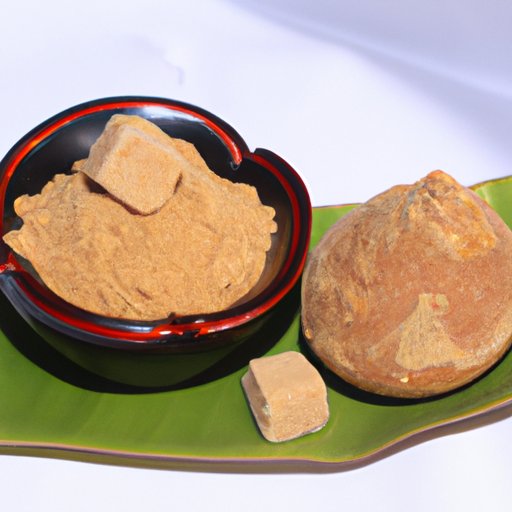Introduction
You may have heard of jaggery as a popular ingredient in Indian cuisine, but what exactly is it? Jaggery is a natural sweetener that has been used for centuries in South Asia and throughout the world. It is made by boiling sugarcane juice until it thickens and then letting it cool and harden into blocks or cubes.
In this article, we will delve deeper into the wonders and benefits of jaggery, including its nutritional value, cultural significance, and versatility in cooking.
Sweetness in a Natural Form: The Wonders and Benefits of Jaggery
Jaggery has a unique texture and flavor that can be described as sweet, nutty, and slightly smoky. It is a great source of energy and contains essential nutrients such as iron, phosphorus, and magnesium. Unlike refined sugar, it has a low glycemic index, which means it doesn’t cause a sudden spike in blood sugar levels.
One of the main benefits of jaggery is its high iron content. Just 10 grams of jaggery can provide up to 4% of your daily iron requirements, making it a great option for people with iron-deficiency anemia. It also contains minerals like calcium, phosphorus, and magnesium, which are essential for healthy bones and teeth.
Jaggery: A Healthier Alternative to Refined Sugar
Refined sugar is a highly processed form of sugar that has been stripped of its natural nutrients. Consuming too much refined sugar can lead to a host of health problems, including weight gain, type 2 diabetes, and heart disease. Jaggery, on the other hand, is a natural sweetener that retains its nutrients and provides a slow release of energy, making it a healthier alternative to refined sugar.
As jaggery is unrefined, it still contains trace amounts of molasses, which is a byproduct of sugar production. This gives jaggery a slightly darker color and a more complex flavor than refined sugar.
From Sugarcane to Jaggery: Exploring the Production Process and Varieties
The process of making jaggery starts with harvesting sugarcane. The juice is extracted, filtered, and then boiled in large open pans until it thickens and starts to solidify. The mixture is then transferred to molds or shaped into blocks or cubes. During the boiling process, impurities are removed, and the remaining molasses give jaggery its distinctive flavor and color.
While sugarcane is the most common source of jaggery, it can also be made from other sources such as date palm and coconut sap. These varieties of jaggery have distinct flavors and are often used in different cuisines.
The Cultural Significance of Jaggery in Indian Cuisine and Festivals
In India, jaggery is a staple ingredient used in many traditional sweets and dishes. It is a common ingredient in sweets like laddoos, chikkis, and halwas, and is often used in savory dishes like samosas and kachoris.
Jaggery also plays a prominent role in Indian festivals and traditions. It is used in puja rituals and offerings as a symbol of devotion and purity. During festivals like Makar Sankranti and Diwali, jaggery-based sweets are exchanged among family and friends as a sign of goodwill and prosperity.
Cooking with Jaggery: Delicious Recipes and Tips
Jaggery is a versatile ingredient that can be used in a variety of dishes, both sweet and savory. Here are some popular recipes that use jaggery:
- Jaggery tea
- Gur ka halwa (jaggery pudding)
- Gur ki roti (jaggery flatbread)
- Coconut jaggery ladoo (coconut and jaggery balls)
When cooking with jaggery, it’s important to keep in mind that it has a strong flavor that may overpower other ingredients. To balance the sweetness, you can add a pinch of salt or spices like cinnamon and cardamom.
If a recipe calls for refined sugar, you can substitute it with jaggery in a 1:1 ratio. Keep in mind that jaggery takes longer to dissolve than refined sugar, so you may need to adjust the cooking time accordingly.
Jaggery vs. Honey: Which Natural Sweetener Should You Choose?
Honey is another natural sweetener that is often used as a substitute for refined sugar. While both jaggery and honey are healthier alternatives, they do have some differences.
For instance, jaggery is a better source of iron and other essential nutrients, while honey has antibacterial and antioxidant properties. Honey also has a lower glycemic index than jaggery, making it a better option for people with diabetes or glucose intolerance.
When choosing between the two, it ultimately comes down to personal preference and dietary needs. If you’re looking for a natural sweetener that is high in nutrients, jaggery is an excellent choice. If you’re looking for a natural alternative with antibacterial properties, honey is a great option.
Conclusion
Jaggery is a natural sweetener that is not only delicious but also packed with essential nutrients. It is a healthier alternative to refined sugar and is often used in Indian cuisine and festivals. Whether you’re looking to incorporate it into your cooking or simply looking for a healthier way to satisfy your sweet cravings, jaggery is a great option to consider.
